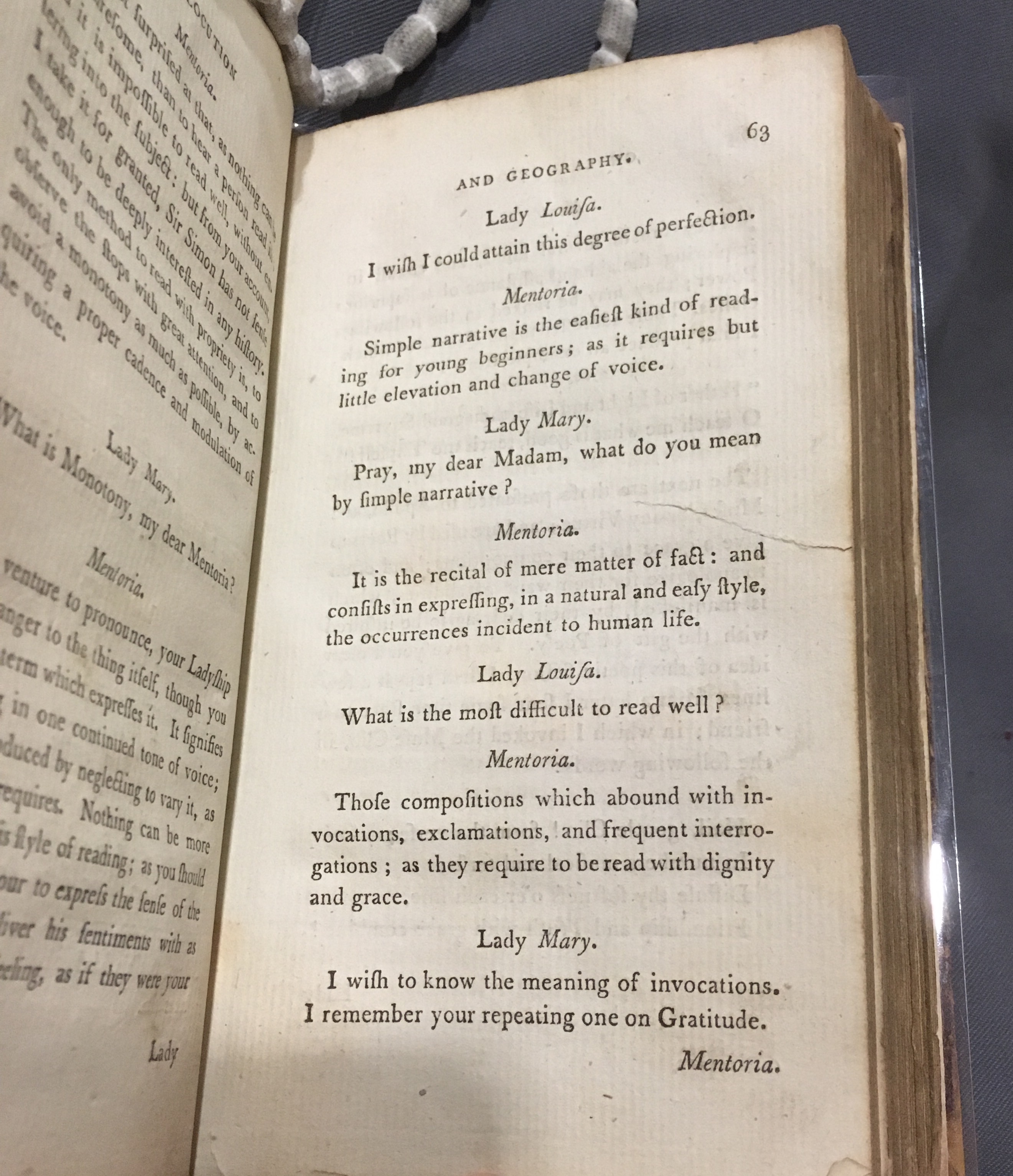
UCLA Special Collections holds this well-preserved copy of Mentoria in its Children's Literature collection. Here the title page and part of the bookplate show annotations and inscriptions. Notice also the varying font size and style utilized for this title page, as well as the decorative pieces.

Mentoria's suggestions on reading aloud. Silent reading was not popular at this time. Additionally, reading well was considered a good quality to have, especially for young women of the middle and upper classes who hoped to marry and be homemakers.
Mentoria: Or, the Young Ladies Instructor by Ann Murry, 5th edition, 1787
Mentoria is one of the earliest conduct books, an oft-researched and contested genre, produced for children. Mentoria is composed in somewhat stilted conversations between a governess and her wards. Conduct books and conduct literature enumerate and enforce expectations, usually of young women, in their speech, daily activities, marriage, and more. The eighteenth-century, especially the Regency period, is particularly famous for conduct literature, which educates through narrative the social expectations of young women. Such novels include Pamela; Or Virtue Rewarded by Samuel Richardson, which was extremely popular and upheld as a "moral novel" at a time when the very genre was the flashpoint for intense cultural divide and ideological debate (See Jane Austen and the War of Ideas). All such conduct literature comes from the tradition of conduct books, which were more explicit in their purpose; though many, like Mentoria, do choose to educate through a framing narrative.
This copy of Mentoria is a fifth edition, and consists of 276 pages of text of varying number of lines due to the dialogue format. It still has its original calf leather binding, which has been rebacked with new corners added. There is no stamping or gold leaf on either cover, though the end of each chapter includes a printed decorative tail piece. The new corners indicate that despite the good condition of the cover, this book was probably used quite a bit. Additionally, there is an inscription of "Marg. A. Clarke, London 1809" in the bookplate, presumably a new owner- twenty years after the copy was printed. A second inscription is dated 1840. The binding remains in a protective plastic cover when used for research, and the binding remains quite tight: the book can be difficult to open fully in places. The paper is a light to medium weight with little drape, and shows chainlines as well as show-through of ink and impressions, particularly of the collation marks. Overall, Mentoria remains in excellent condition for its age and use; which is not always true of conduct books specifically (See Burns Library).
In Mentoria, each conversation between the governess and her wards focuses on a subject such as grammar or geography, but throughout the lessons Murry emphasizes conservative values of the late eighteenth century, especially female virtue and religious devotion within the Church of England (Sage, 457). Interestingly, Murry includes poems by John Milton, author of Paradise Lost, and Thomas Pope, a poet who served under the Catholic Mary Queen of Scotts, as illustrative examples. Murry also composed much of the verse herself, as she was a poet in addition to a tutor and a children's author.
Murry, who was very well-educated by her family, turned to private tutoring when her father's London wine business failed, leaving her to support herself (Sage, 457). The first edition of Mentoria was published in 1778, and it was so popular that it was reprinted well into the 19th century (Sage, 457). Mentoria was also one of the books which Jane Austen owned and read as a young girl, which is particularly interesting because Austen's relationship to conduct books and conduct novels continues to be a highly debated topic in academic discourse to this day (Le Faye, 49). By 1791, Ann Murry had been appointed to preceptress of the Royal Nursery, presumably employing similar methodologies and lessons in her teaching of the royal family as explicated in her bestselling conduct book (Sage, 457). Murry likely would have been responsible for teaching the youngest of King George III's fourteen children, as many of the elder children were well into their adulthood by 1791.
References
The Cambridge Guide to Women's Writing in English: by Lorna Sage
John Burns Library: 18th Century Conduct Literature
Jane Austen: A Family Record: by Dierdre La Faye
Jane Austen and the War of Ideas: by Marilyn Butler
See Also: Library of Congress Etiquette Books and Prescriptive Literature
This spotlight exhibit by Micaela Rodgers as part of Dr. Johanna Drucker's "History of the Book and Literacy Technologies" seminar in Winter 2018 in the Information Studies Department at UCLA.
For documentation on this project, personnel, technical information, see Documentation. For contact email: drucker AT gseis.ucla.edu.